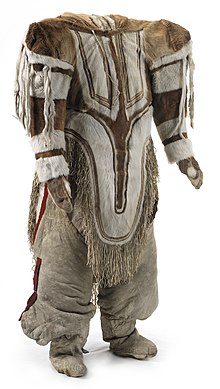
Back Inuita vesto Esperanto پوشاک اینوئیتی Persian ᐊᓐᓄᕌᓂᒃ IU ინუიტური ტანისამოსი Georgian Inuittiske klede NN


Traditional Inuit clothing is a complex system of cold-weather garments historically made from animal hide and fur, worn by Inuit, a group of culturally related Indigenous peoples inhabiting the Arctic areas of Canada, Greenland, and the United States. The basic outfit consisted of a parka, pants, mittens, inner footwear, and outer boots. The most common sources of hide were caribou, seals, and seabirds, although other animals were used when available. The production of warm, durable clothing was an essential survival skill which was passed down from women to girls, and which could take years to master. Preparation of clothing was an intensive, weeks-long process that occurred on a yearly cycle following established hunting seasons. The creation and use of skin clothing was strongly intertwined with Inuit religious beliefs.
Despite the wide geographical distribution of Inuit across the Arctic, historically, these garments were consistent in both design and material due to the common need for protection against the extreme weather and the limited range of materials suitable for the purpose. The appearance of individual garments varied according to gender roles and seasonal needs, as well as the specific dress customs of each tribe or group. The Inuit decorated their clothing with fringes, pendants, and insets of contrasting colours, and later adopted techniques such as beadwork when trade made new materials available.
The Inuit clothing system bears strong similarities to the skin clothing systems of other circumpolar peoples such as the Indigenous peoples of Alaska, Siberia and the Russian Far East. Archaeological evidence indicates that the history of circumpolar clothing may have begun in Siberia as early as 22,000 BCE, and in northern Canada and Greenland as early as 2500 BCE. After Europeans began to explore the North American Arctic in the late 1500s, seeking the Northwest Passage, Inuit began to adopt European clothing for convenience. Around the same time, Europeans began to conduct research on Inuit clothing, including the creation of visual depictions, academic writing, studies of effectiveness, and museum collections.
In the modern era, changes to the Inuit lifestyle led to a loss of traditional skills and a reduced demand for full outfits of skin clothing. Since the 1990s, efforts by Inuit organizations to revive historical cultural skills and combine them with modern clothing-making techniques have led to a resurgence of traditional Inuit clothing, particularly for special occasions, and the development of contemporary Inuit fashion as its own style within the larger Indigenous American fashion movement.